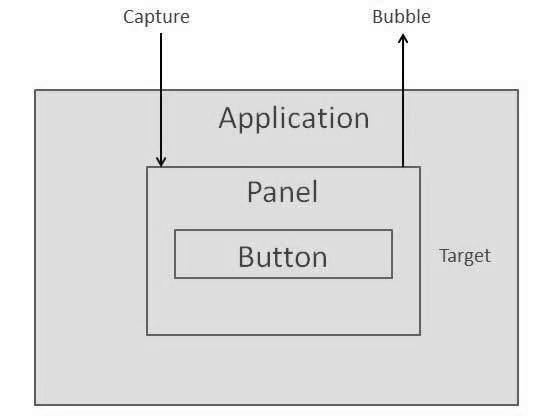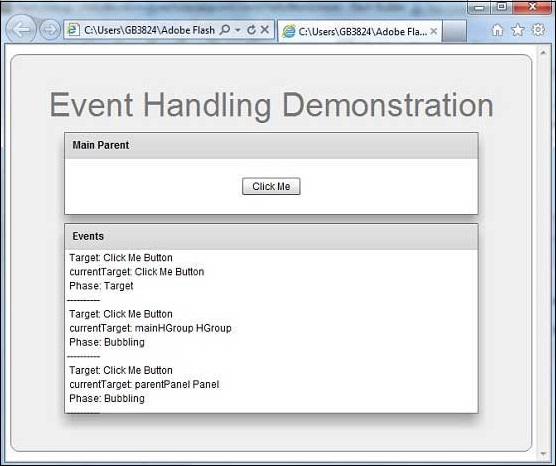Flex uses concept of event to pass data from one object to another
depend upon the state or user interaction within the application.
ActionScript has a generic
Event class which defines much of
the functionality needed to work with events. Every time an event occurs
within a Flex application, three types of objects from the Event class
hierarchy are created.
Event has the following three key properties
| Property | Description |
|---|
| type | type states about what kind of event just happened.
This may be click, initialize, mouseover, change, etc. The actual
values will be represented by constants like MouseEvent.CLICK. |
| target | The target property of Event is an object
reference to the component that generated the event.If you click a
Button with an id of clickMeButton, the target of that click event will
be clickMeButton |
| currentTarget | The currentTarget property varies container hierarchy. It mainly deals with flow of events. |
Event Flow Phases
An event goes through three phases looking for event handlers.
| Phase | Description |
|---|
| Capture | In the capture phase the program will start
looking for event handlers from the outside (or top) parent to the
innermost one. The capture phase stops at the parent of the object that
triggered the event. |
| Target | In the target phase ,the component that triggered the event, is checked for an event handler. |
| Bubble | The Bubble phase is reverse of capture phase, working back through the structure, from the target component's parent on up. |
Consider the following application code
<?xml version="1.0" encoding="utf-8"?>
<s:Application xmlns:fx="http://ns.adobe.com/mxml/2009"
xmlns:s="library://ns.adobe.com/flex/spark"
xmlns:mx="library://ns.adobe.com/flex/mx"
width="100%" height="100%"
minWidth="500" minHeight="500" >
<s:Panel>
<s:Button id="clickMeButton" label="Click Me!" click="doAction( );"/>
</s:Panel>
</s:Application>
When the user clicks the Button, he or she has also clicked the Panel
and the Application.The event goes through three phases looking for
event-handler assignments.

Let us follow the following steps to test event handing in a Flex application:
| Step | Description |
|---|
| 1 | Create a project with a name HelloWorld under a package com.tutorialspoint.client as explained in the Flex - Create Application chapter. |
| 2 | Modify HelloWorld.mxml as explained below. Keep rest of the files unchanged. |
| 3 | Compile and run the application to make sure business logic is working as per the requirements. |
Following is the content of the modified mxml file
src/com.tutorialspoint/HelloWorld.mxml.
<?xml version="1.0" encoding="utf-8"?>
<s:Application xmlns:fx="http://ns.adobe.com/mxml/2009"
xmlns:s="library://ns.adobe.com/flex/spark"
xmlns:mx="library://ns.adobe.com/flex/mx"
width="100%" height="100%" minWidth="500" minHeight="500"
>
<fx:Style source="/com/tutorialspoint/client/Style.css"/>
<fx:Script>
<![CDATA[
protected function reportEvent(event:MouseEvent):void
{
var target:String = event.target.id;
var currentTarget:String = event.target.id;
var eventPhase: String;
if(event.target is Button){
var button:Button = event.target as Button;
target = button.label + " Button";
} else if(event.target is HGroup){
var hGroup:HGroup = event.target as HGroup;
target = hGroup.id + " HGroup";
}else if(event.target is Panel){
var panel:Panel = event.target as Panel;
target = panel.id + " Panel";
}
if(event.currentTarget is Button){
var button1:Button = event.currentTarget as Button;
currentTarget = button1.label + " Button";
}else if(event.currentTarget is HGroup){
var hGroup1:HGroup = event.currentTarget as HGroup;
currentTarget = hGroup1.id + " HGroup";
}else if(event.currentTarget is Panel){
var panel1:Panel = event.currentTarget as Panel;
currentTarget = panel1.id + " Panel";
}
var eventPhaseInt:uint = event.eventPhase;
if(eventPhaseInt == EventPhase.AT_TARGET){
eventPhase = "Target";
} else if(eventPhaseInt == EventPhase.BUBBLING_PHASE){
eventPhase = "Bubbling";
}else if(eventPhaseInt == EventPhase.CAPTURING_PHASE){
eventPhase = "Capturing";
}
reports.text += " Target: " + target + "\n currentTarget: " +
currentTarget + "\n Phase: " + eventPhase + "\n----------\n";
}
]]>
</fx:Script>
<s:BorderContainer width="630" height="480" id="mainContainer"
styleName="container">
<s:VGroup width="100%" height="100%" gap="10"
horizontalAlign="center" verticalAlign="middle">
<s:Label id="lblHeader" text="Event Handling Demonstration"
fontSize="40" color="0x777777" styleName="heading"/>
<s:Panel id="parentPanel" title="Main Parent"
click="reportEvent(event)" width="500"
height="100" includeInLayout="true" visible="true">
<s:layout>
<s:VerticalLayout gap="10"
verticalAlign="middle" horizontalAlign="center"/>
</s:layout>
<s:HGroup id="mainHGroup" click="reportEvent(event)">
<s:Button label="Click Me"
click="reportEvent(event)"/>
</s:HGroup>
</s:Panel>
<s:Panel id="reportPanel"
title="Events" width="500" height="230">
<mx:Text id="reports" />
</s:Panel>
</s:VGroup>
</s:BorderContainer>
</s:Application>
Once you are ready with all the changes done, let us compile and run the application in normal mode as we did in
Flex - Create Application chapter. If everything is fine with your application, this will produce following result: [
Try it online ]

 Let us follow the following steps to test event handing in a Flex application:
Let us follow the following steps to test event handing in a Flex application:
 Let us follow the following steps to test event handing in a Flex application:
Let us follow the following steps to test event handing in a Flex application:

No comments:
Post a Comment